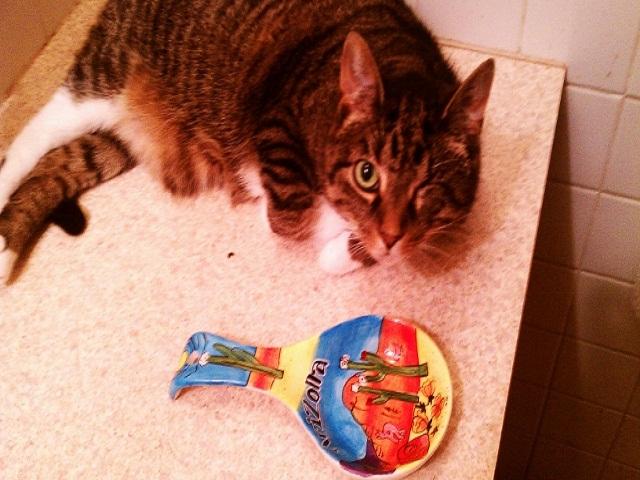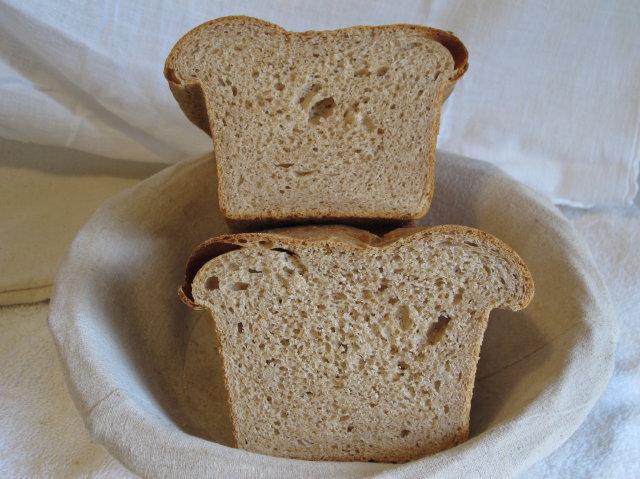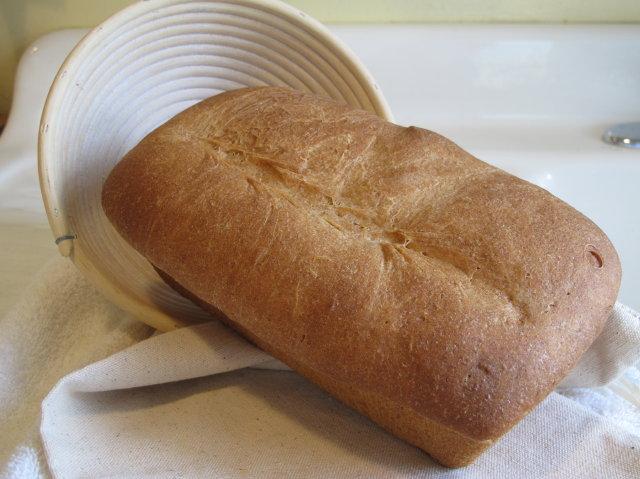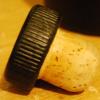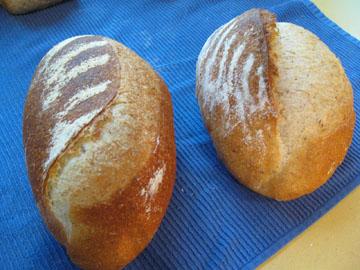Search the Community
Showing results for tags 'Bread'.
-
I’m putting together a little series of Welsh breads. I’m not looking for “authenticity” – there don’t seem to be many sources of authentic recipes. I’m just taking what there is and if it’s yeasted, converting it to sourdough, if it’s cooked in a cast iron pot trying out versions that can be made in an oven, trying to work with local flours. Anyway, I’m reading Bobby Freeman’s “First Catch Your Peacock” and she gives a recipe for Steamed Brown Bread from Caernarfonshire, now part of Gwynedd where I live, which she says comes from “Farmhouse Fare” 1966 edition, a compilation of recipes from Farmers Weekly magazine. She says it was baked in stone marmalade jars which made me think of Boston Brown Bread being baked in coffee tins. So I dig out a recipe for Boston Brown Bread and …. the recipes are identical. At first I think, “Wow, Boston Brown Bread must have come from this traditional Welsh recipe!”. But then I think, someone sent this recipe to a farmers’ periodical in 1966. Did they just happen to have an American recipe that they thought other people might like to make? Can anyone cast light on the origins of Boston Brown Bread or about Welsh Steamed Brown Bread?
-
Not that I've made any bread recently, but as of a year ago I was making variations on Bittman's no-knead bread fairly frequently, often experimenting with various kinds of flour, including whole wheat. I was never able to get a crispy, crackly-crusted loaf with majority whole wheat without the bread being EXTREMELY dense. I was in Switzerland recently, and had the best bread I've ever had anywhere - it was dark-ish, seemed to be whole wheat, with a great crust and nice open-holed crumb. Is there a way I can do this at home simply?
-
I recently decided to venture into the world of sourdough. I wanted to use a wild yeast starter. Following directions I found on the web I mixed 1oz of water with 1 oz of flour. Mixed. Day 2 I mixed. Day 3 added same amounts of flour and water. A few bubbles. Day 4 more bubbles, fed it again. Day 5 and 6 still more bubbles and fed each day. Day 7 fewer bubbles, texture thinning, fed again. Added a small amount of dried yeast. Day 8 tried to make bread. Did not rise. What happened?
-
Hello, I bake danish style rye bread (similar to this) about every 2 weeks and I have a good sourdough going for this (called Charlotte for the work colleague who gave it to me - one does get attached to one's sourdough). My sourdough starter is all coarse rye flour. Here's the question: is it possible, and how do I go about it, to convert a jar of the all-rye starter to a starter that can be used for lighter bread types, pizza etc - the flavour in the rye is very good. Thanks
-
I have a friend who has some pretty severe food allergies- gluten, corn, soy, dairy to name just a few. I've managed to put together two bread recipes he's able to enjoy and have been asked to utilize one of them to make a cake for his SO. One of the two is actually made in a bundt pan, but that's not the one she has requested, and since I've never been tasked w/such a conversion (and won't be there to taste test!), I wanted to pose the question here before I begin (was asked this afternoon to drop off tomorrow on my way out of town, yikes!). Both recipes come from the Gluten Free Goddess blog, both were incredibly good, receiving raves from the large group assembled the day I brought them to share. Here's what I am needing to get to be beautiful and yummy from a bundt instead of a loaf pan, already modified with changes made for his diet (original here): Can use loaf pan or 8x10 baking pan per the recipe. Combine: 1 cup canned pumpkin 1/2 cup safflower oil 1 cup packed organic light brown sugar 2 teaspoons McCormick vanilla extract (w/o corn syrup) 2 antibiotic-free eggs 1/2 cup orange juice Whisk together in a separate bowl: 1 1/2 cups gluten-free flour blend (Red Mill AP mix) 1 teaspoon baking soda 1 1/2 teaspoons baking powder 1/2 teaspoon salt 1 teaspoon xanthan gum 1 teaspoon cinnamon 1/2 teaspoon cardamom 1/2 teaspoon ginger 1/2 teaspoon ground cloves Add the dry ingredients into the pumpkin mixture and stir until smooth. If the batter looks too thin and wet, add more gluten-free flour, a tablespoon at a time, to thicken the batter. Also... I'd like to make a glaze and was originally thinking 10x, ghee, a little vanilla, maybe steep a chai bag in some almond milk to stir in... but it just occurred to me that I will be unable to use regular 10x sugar due to the cornstarch. I would REALLY appreciate any insight or ideas to get around that, as well. Thanks so much!! Stephanie
-
So i tried making this Laura Hart's sourdough recipe which involves making a starter dough with a 1:1 ratio of 'strong' plain flour and water. Im not sure what she meant by strong so i just used half and half of bread flour and AP. Now i basically messed some part up involving me putting the starter inside the oven set onto warm and it warping the plastic container i placed it in accidentally (stupid i know, i didnt even need to put it inside the oven i dont know why i did that), so i tried scooping out what i could but now the ratio of flour to water had been messed up. I tried adjusting it by feeding it with another 1:1 ratio of flour and water and waited to see what would happen. Anyway i carried on with the recipe but in half and forgot to half the amount of salt put in also. The dough i felt didn't really rise during the supposedly rising process but i carried on and also did the whole kneading thing. OK so i FEEL like i might have overworked my dough (i just kept on kneading it every now and then hoping something would happen)and its been sitting there for the last 24 hrs or so. I decided to cut a chunk off to make a mini-roll of sort, baking it at the same temp (less time) and the results was what i was expecting: heavy tough bread. It had some holes in it so im guessing part of it did rise but so im wondering whether: 1.) Did i over work it? 2.) My amount of flour + water to starter was way off (not enough starter) 3.) too much salt (but i think thats for flavor) Ideas? Also anyone have any suggestions on what to do with over worked sour dough? I tried kneading it down to make a sorta pizza thing but again, its just tough dough which didnt do to well to rolling out thin. If not i was thinking just bake it off and turn it into bread crumbs
-
Hi, Was going to bake some sourdough tomorrow so I prepared everything yesterday and today. I turned my wet starter into a firm one and let it ferment for 8 hours. Then I turned my firm starter into a levain and let that ferment for 8 hours. Then I let my levain retard in the ref for the final dough mixture tomorrow morning. But, I got a call and I can't work on it tomorrow anymore. So my question is how long can I keep that fermented levain in the ref and keep it fully active until I can finish the dough for baking? Thank you!
-
So I picked up some Ischia Island ( Italian ) Yeast from Sourdough International. Activated it by Sourdo.com instructions!! http://www.sourdo.com/home/activation-i ... s-english/ 90 degree water bath: Day 1 24 hrs 1 pk of yeast Ischia Island 225 g of Mountain Spring Water .. close to 1 C 105 g of Guisto OO Flour So after 24 hrs in a 90 degree water bath: I seperated the culture into two containers, as said I feed both containers with : 140 g of the " 00 '' Flour and 170g of spring water after the morning feeding of Day 2 3-4 hrs later I had this!! So it looks activated ? I'm making pizza dough today.. How do I take care of this stuff, now? Can I leave it on the counter, for weeks? Or should I refrigerate it till using it next week? Little help please and any pizza dough weight recipe?
-
I recently moved from Victoria to Vancouver and was surprised to find a lack of great bread. So far the best has been Ace Bakery bread at the Superstore!!!!!!!!! I've been spoiled by Wild Fire and Fol Epi and Church Bakery in Comox. I realize this question keeps getting asked but I'm still stuck on where to get decent, slow rised, natural yeast, possibly wide fired oven bread. Any suggestions?
-
Greetings, baking experts! Here's a mix which King Arthur Flour sells to "improve" rye breads: A blend of rye flavors and sours, diastatic malt, vital wheat gluten (for a good, strong rise) and potato flour (to help combat the "dry crumblies" Does this mean one can add some of these things to a rye bread recipe to lighten it up? I have a tasty recipe from a class I took years ago at The French Pastry School in Chicago -- great place, BTW. Anyhooo, when I make this bread at home, it rises a fraction of an inch in several hours' time, and bakes up like a brick! Waaa? It has great flavor, but you need the jaws of life to get a bite. Any suggestions?
-
Well, it’s officially Sunday and we have a whole lot to cover this week, so...hello and welcome to Missouri. I’m a troll’s troll. And as much as I’d like to pretend that I actually DO live under a bridge waiting for goats to walk by, I am looking forward to putting my OCD to work and showing you a little bit of “MY Kansas City”. To begin my blog I’ll open it with an absolutely true story…in addition to changing the way I approach food, whether it’s dining in a new city or trying a new recipe, I owe the largest part of my happy life to eGullet. For it was HERE that my lurker wife (I’m sure she’ll pop in here at some point) first spotted my gleefully grammatically challenged wordsmithing and began to stalk me…and it went like THIS- A few months after my gastric bypass surgery in 2007, I hosted a dinner party and talked about it on the Sopranos food thread: The Sopranos Dinner Thread So she saw that and was like “Oh man, this guy is going places!”, and she fell into the vortex that is my blog (which DOES contain adult themes and language…BIG time) after hopping over there to read the extended version of the dinner. My blog is kind of like a landfill and gets about ten accidental visits per day, one comment every three months…it is absolutely shill and self-promotion proof. So in the interest of including some important non-food info I’ll link to a specific post without feeling too bad about possibly boosting my traffic to twenty over the next few days. If you skip to the third comment, that is where this whole story took off after a random dinner party report. My wife-to-be happened to post to something I wrote about online dating...comments complete with John Cusack references. Anybody here have a heart?!?! Isn’t it PRECIOUS?!?!? Thoughts about dating that reeled in a wife... And so thanks to eGullet we were off and running! I was in Kansas City, she was in Richmond, Virginia...and after several months of phone calls and literally hundreds of pages of emails we arranged our first face time. Planning for a worst case scenario, she would drive to DC (which would give her a quick escape if needed), and I would fly in and have three days to eat and drink in that town…with our without her. So where was our official “first date”? Is that a rhetorical question? We were going to be in DC, and you don’t remain a bachelor until almost forty without learning a thing or two about “classy” first dates. So no brainer…minibar. BOOM. You can’t make that stuff up. And my wife mentioned how much she likes it when the eG food bloggers include a picture, so here you go- this is us on that first date, at the bar at Café Atlantico, waiting to be summoned upstairs: We had a small destination wedding in Savannah, Georgia in Whitefield Square’s gazebo. On June 25th we celebrated our second anniversary during a roadtrip to Deadwood, South Dakota (Corn Palace, Wall Drug, the works). We live in Parkville, Missouri, which is about ten minutes northwest of downtown Kansas City (Missouri…there’s another one in Kansas ). No kids, but we do have three rescue animals...one cute but common decency-challenged cocker spaniel and two one-eyed cats. Overall, life right now is grand. And this is a FOOD blog, but I will add that what makes life so great is making it through a pretty crazy first couple of years...I mean, we did everything you’re NOT supposed to do. Long distance relationship where we both bounced back and forth between Richmond and KC, planning a wedding with the full knowledge that in a few months I would be laid off from my job, getting married and then having her leave home to move a thousand miles away...finally arriving here with no job prospects and me being out of work for what ended up being seven months. 2009 was crazy….five people in my family died that year, I got married, I quit drinking, my whole team got laid off, my bachelor pad was about to be retrofitted for estrogen-friendliness, wife looking for a job, a one-eyed cat thrown into the mix...you don’t realize how crazy it is when you’re in the middle of it. So now I am literally thankful every single day for what we’ve got; we’re both employed (I’m in IT, she’s in healthcare), we have a happy home, great family and friends...and we love our food. When the good times come you devour them, and you pass on as much good as you can to others. And life will always come back and happen to you at some point…and sometimes quickly, sometimes slowly, the good times will return. And when they DO return, YOU CELEBRATE WITH A FANTASTIC MEAL! So I just wanted to give that little backdrop to set up what I’m wanting to do with this week. I could have gone a million different directions or just try to make this what I think of as “eGullet-y”. But as my wife told me, there isn’t really any NEW ground to cover on this site, so best to just personalize it and see where it goes. I’m just going to blog how I blog, food-centric and minus the wildly excessive profanity... other than that pretty unedited and full of self-amusement. You’re going to see some good food, I promise you that. I’m going to test your limits with my rambling, horrible photography, and movie references...and I AM the king of the ellipses... but it’s going to revolve around food, who we are, and what makes us love eating in KC. I’ve lived in Arizona and Minneapolis, but Kansas City Kansas is where I was born (on the 4th of July!) and most of my life has happened in the major metropolitan area. I moved to the Missouri side after my broken-hearted return from Minneapolis in 1995, because it is just better than Kansas. Sorry, it’s just true . I’ll have to leave a lot of stuff out that may tweak folks familiar with the area, but I’m always available for questions, requests, and whatever is of interest about food in my town. If it exists here, I’m probably at least aware of it, I am deeply familiar with the current scene, and we eat EVERYTHING, too bad we've only got the week. Like many eG bloggers it will be a big one-off as far as overall dining costs and calories in a seven day span. Oh, and here’s the big kicker...no BBQ. I create world class bbq, I love talking about it, and am happy to chit-chat, but that is one serious all-or-nothing topic. Plus, a Kansas City blog without bbq is just funny. I gotta be FREE! Some NEW stuff! For its size, Kansas City has an amazing food community, and I will give you just a tiny fraction….and please ignore any eye-rolling and fact checking from other KC eGulleters because MY KC is the coolest version...full of folklore and intrigue!!! Oh, and “zeemanb” is a screen name I’ve used since around 1995 when I first got online. Sadly, some from KC think it has something to do with the Z-Man sandwich at Oklahoma Joe’s BBQ…but cheese belongs on bbq about as much as mango chutney or pop rocks…or bbq sauce…so not hardly. I took the name from the character Z-Man Barzell in the Russ Meyer classic “Beyond the Valley of the Dolls”, written by Roger Ebert. My holy trinity of movie directors would be Stanley Kubrick, John Waters, and Jim Jarmusch...so there is a big clue into my voice and worldview- with deepest apologies. In the morning I’ll detail how we approach hard narcotics, er, I mean COFFEE in this house. We’ve got friends coming over in the afternoon for some Ad Hoc fried chicken, and I am DYING to post dinner from tonight. I know it happened a couple of hours earlier than the start of the blog, but I assure you it is not to be ignored. Gotta hit the hay, so until then here are a few random shots to tide you over: Photo of my favorite spoonrest. And by favorite, I mean my only spoonrest: We find that the best use for the extra plastic grocery baggies we steal is- cheap cat toy: Lastly, before I head to bed, here is some super cool food photography we bought while we were on our anniversary roadtrip: More rambles once I get the caffeine in my veins.....
-
Greetings, bread experts! I've been baking in a commercial gas convection oven for loaves sold at a Farmer's Market, and struggling to get the same spectacular rise I used to, out of my electric oven. I've learned a few things: proofing for longer in the pans makes breads rise higher in the oven; just a little overproofed results in a higher rise in the oven, for some reason. Also using a stone makes a big dif! Even when strap pans are just placed on the stone, the breads seem to be higher. And using steam, of course. But still not nearly as good as with an electric oven, on a stone, with steam just sprayed. I'm wondering if my first bulk rise could be cooler, and it would create more energy for the second rise, and final oven burst. Currently, I'm bulk rising in a warming oven at 100 degrees or slightly over, for about 1.5 hours. Maybe a cooler 90 degrees (or lower?), for longer would help? I'm also wondering if turning off the fan for the first 5 minutes or so would make for a higher initial burst, when steam is applied to the sides with a sprayer (also over the tops of the loaves). I've read that gas won't give the same results as electric, and that turning off the fans results in not much. I've also been told that using a cover, sprayed on the inside with water, over the loaves works well. I've had limited success as far as getting my loaves to look like their electric counterparts, with this technique. And it's a pain! What's your experience/recommendation?
-
I'm thawing fish to make a favorite fish fry for tomorrow. The breading is made with besen, yogurt, water and selected spices. You can add egg but my teacher told me that it dries out the breading and his secret to make the coating for the fish crispy was to add a few tablespoons of rice flour. This got me thinking, what are techniques for making the breading in fried foods crispy and what is the science behind it? When I was in India I'd go by some street venders and eat crunchy fried vegetable snacks but the same snacks down the road, fresh out of the frier, were soft by comparison. Kentucky Fried Chicken in Japan says extra crispy but it's oily and soft. I suspect temperature has something to do with it but I wonder what ingredients make the better, crispier batter. Any thoughts out there?
-
Greetings, expert bakers! I've been baking for farmer's markets in a commercial kitchen for a few weeks now, and am trying desperately to get a prettier product from the gas convection oven I'm using. It has great capacity, and is calibrated perfectly, but bakes so evenly that my breads have an all-over brown color, even the grigne, which makes them look very dull, in my opinion. I was getting fabulous beautiful loaves (and I think they rose higher, too!) from my Vulcan electric, which has a top control, which I set to "high" when the breads went in, on a stone, at 450°. I was able to use steam, also, since there was no fan. Now I'm baking on a sheet pan at 400° convection, and not really liking the results. So can I just not use the fan? There's a huge disclaimer right on the front of the oven that states the fan MUST be on when the gas is on, yikes! Don't want to blow up the kitchen, but isn't it OK to bake without the fan in a convection oven, usually? Your valuable input gratefully acknowledged, thanks!
-
Do you slice it thick, thin, on the bias, never? I'm starting to realize that there's a lot of variation here.
-
Greetings, bakers. I've recently leased a commercial kitchen space to bake a poolish-starter white/whole wheat flax bread to sell at Farmer's Markets. The oven I'm using is a gas convection, with no provisions for steam or stone baking. Just racks and the fan. At home, I was baking on a stone, with steam provided using an old sheet pan and chunks of marble in the bottom, heated with the preheat, and hot water splashed on, when the loaves went in. Now I load the loaves onto a sheet pan, and shove 'em in at 400°F for about 15-20 mins., depending on the size. I get a nice oven burst, and they look great, but I'm finding more tunnels at the tops, than I did with the home baked loaves. Here's my recipe: Poolish: 100% hydration 12 oz. strong flour 12 oz. water 1.5 tsp. instant yeast ferment for at least 4 hours. add: 65 oz. water (62% hydration) 90 oz. strong flour 20 oz. whole wheat flour 2 oz. ground flax seed meal 1 oz. whole flax seeds 3 T. salt 1.5 tsp. instant yeast The first rise is at 100° in a warming oven, the second after shaping is at room temperature, which is about 65 degrees (I work in a meat processing plant), and each takes about 1.5 hrs. I form the loaves in the standard baguette manner, fold, seal, fold, compress and roll a bit, to make 17 oz. torpedo shaped loaves. What is your experience with large holes at the tops of breads? Are they formed during shaping (my internet search indicated "poor machining of dough" as a reason -- I have no idea what that means!), or is it because of the baking temperature/time/method? Help! No one will buy my loaves if they're holey! Thanks in advance for your expert advice.
-
Greetings, baking professionals! I'm a hobby baker, who's been invited to demonstrate bread forming and braiding techniques at an outdoor art fair. I'm thinking it would be fun to have people watch my demo, then do their own shaping and forming with their own little piece of dough. Everybody wants to learn how to make bread! But the rub is that the dough can't be consumed, as the health dept. will come down on me like flies on sh*t, if you know waddeye mean. So I'm wondering if there's a recipe out there for dough that might kinda act like bread in terms of moisture and texture, but not rise (I'll be outdoors in June), or even be edible, necessarily. Any thoughts?
-
I've recently started cooking from Reinhart's newish "Artisan Bread Every Day" and I really like the book. I think the technique he uses throughout the book is pretty easy to work into even a very busy schedule. My first bread from the book was the Focaccia and it turned out to be spectacular and really reminded me of a bakery that I used to live near that had the best rosemary focaccia I've ever eaten (I used Reinharts herb oil as a topping). The only problem I had was that I forgot to put down parchment and the bread stuck A LOT. I had oiled it well and the sheet was non-stick but none of that seemed to matter. Has anybody else done much baking from this book? What are the must try recipes?
-
I recently read about sprouted wheat flour in Peter Reinhart's Pizza Quest blog. That discussion led me to try making some sprouted wheat flour bread, after I sprouted some wheat, dried it, and milled it. Then I made a simple flour/water/yeast/salt loaf with 90% hydration--as Peter suggested, the flour easily accepted this extreme hydration and remained intact and elastic. The dough was prepared in the food processor, with several breaks for the flour to hydrate before the final kneading; left to rise about an hour before retarding in the refrigerator for 3 days (unexpected work problems interfered with the original plan of holding the dough overnight only before rising/proofing/baking); then the dough was turned out, lightly kneaded and shaped into small round loaves, proofed in a 100° oven, and then baked. I am still lousy with a lame so it was essentially unslashed. The problem? Despite cooking the bread to an internal temperature of 205 degrees, the crumb was damp, sticky, and gummy (though still quite tasty): and I recognize this is a common fault in my breads that long predates the experiment with the sprouted wheat flour. I usually am working with fresh non-sprouted whole wheat flour, prepared in my impact mill a few minutes before I make the dough, prepare the dough in the food processor per the directions from Van Over's Best Bread Ever and many of them experience extended refrigeration between the first kneading and before shaping/proofing (not always intentionally). I'm not sure where to look for the source of the faulty crumb: if the loaves are simply underbaked, does that suggest that these high-hydration whole wheat breads need to be brought to a higher internal temperature than white flour breads? Is the long-rise a likelier suspect? A problem common to freshly milled flour? Or is there some other systematic fault I should be investigating?
-
I am a novice in baking and am attempting to make some brioche out of curiosity. The recipe that I got instruct me to add in some milk, yeast and sugar and wait until its ready to mix with the rest of the dry ingredients. How would I know when its ready? I googled about it and I know that they are meant to go frothy, but it has been almost over 45 minutes now and it still seem rather liquid. I did warmed up the milk a little, and am wondering what did I do wrong? Could it be the content of the sugar, which was 1/4 cup of milk, 1/4 cup of sugar and i sachet of 75 g of dry yeast! Any advice?
-
Okay, it's time. Time again for me to try another one of those Cook's Illustrated recipes. Just like I did last December, when I tackled their "Best pizza ever" recipe. Without hesitation, I can say that the pizza dough I made using that recipe really came out great. Well, once this month's Cook's Illustrated arrived, how could I wait? There it was, right on the cover - "Secrets to Perfect Whole-Wheat Bread." Of course, the whole cover of Cook's Illustrated is, ummmmm, covered with those types of pronouncements. For example, just on that same issue's cover we had: Dressing Up Steaks - Shortcut to 4-Star Pan Sauce Broccoli-Cheese Soup - Throw Out the Rule Book Real Boston Cream Pie All About Butter Who knew it was so easy? But that's what makes Cook's Illustrated great, and also one of the few food mags that I literally read cover to cover. Now, onto those perfect loaves of whole-wheat bread. First, understand that it takes 18 - 24 hours from the start until you actually have something resembling a loaf of bread that can be eaten. Second, I can literally take a 10 minute walk to the Essex St. Market and buy a great, artisanal whole wheat bread for about $4 a loaf, which makes me think that it's a lot of work, and takes a lot of time, to make my own. And unless it's categorically better than Pain d'Avignon's, why bother? Well, I'm a cook, and I'm a food geek, so why the hell not? Also, I had all the ingredients on hand. I didn't take pictures of the process, only the results, but you start the night before with a biga (which is a starter, which is a pre-ferment, which is…well, plenty of topics about that) and also a soaker, which allows the whole-wheat flour to develop to its fullest potential. The next morning, you actually put the dough together - and having a Kitchen Aid or other heavy-duty stand mixer comes in handy; otherwise, prepare for lots of kneading. Once the dough comes together, then it's only about 3 more hours till it's baked, and 2 more till it cools enough to cut into. Whew. Now, before showing you the finished product…a mea culpa. Instead of the bread flour called for in the recipe, I mistakenly used all-purpose flour, and that may be the reason for one of the admittedly minor grievances I had with my loaves. So here's what the bread looked like after baking… And then the loaf cut in half… And finally, a close-up… A couple of things. Take a look at that 'tunnel" up in the right-hand corner of the slice. Not good. Not terrible, but probably not something I should be proud of. Next, see how the "crumb," which is the interior texture of the loaf, gets tighter and tighter towards the bottom of the slice? That's called, I believe, pudding-y (jack?), or at least something like that. Whatever it's called, it's not what you're looking for. It might be due to the lower gluten content of the flour I used vs. bread flour. Taken altogether, not a bad first attempt, and when I made Significant Eater a peanut butter & jelly sandwich, she commented on how delicious the bread was . But, if anyone has any suggestions as to what might've gone wrong - I'm all ears. Although next time, I'll probably just head over to the market - it's so much easier.
-
Looking through the archives, I've seen the topic of fat in general and how it affects bread. However, I was wondering if there is a difference in the way particular fats affect bread and rolls. For instance, does shortening produce a softer crumb than butter? Does oil provide a chewier crust than shortening? Etc...
-
I've seen in several books over the last year of baking that the wild yeast in sourdough comes from the actual grain that the flour is made of and does not come from the air in one's kitchen as many believe. The idea of "capturing" wild yeast would therefore be a myth. If this is true, then is there any real point in making bread this way instead of just buying a known good starter culture? Either way, you are just bringing the wild yeast into your home in a bag as opposed to the romantic notion of capturing a unique blend of wild yeasts native to your home region.
-
As a kid my all time and forever favourite thing was my dad's spaghetti bolognese. My dad would use however much beef mince my mum had leftover from making rissoles (translation into non-Australian English: meatballs in instant gravy), 'some' onion, 'some' jarred garlic, 'some' curry powder, 'some' tomato paste and 'some' Vegemite. Vegemite is an Australian product but it is, for the purposes I'm looking at, basically the same thing as Promite and Marmite. Over the years I've cooked many variations of bolognese but none of them, no matter how many different ingredients go in, taste as good as my dad's version. The sauce, no matter whether I use mince (fresh or supermarket-grade), diced meat or a combination thereof, is never as 'meaty' as what his sauce was. And he wasn't using organic free range whatever from the back paddock: it was really cheap butcher's mince or supermarket mince. The other day I finally worked up the nerve to spoon Vegemite into my bolognese. And, you know what? I finally cracked the recipe. It was the Vegemite, odd as it sounds, that gave my dad's bolognese sauce that real meaty quality. You can't taste it in the end product. It's not like what you imagine buttering a steak all over with Vegemite to be like. After a hour or so simmering away, it just makes the meat part of the sauce's flavour taste meatier. Has anyone else experimented with the various *mite products avaliable? I'm meaning to get around to experimenting with other dishes--I see potential in other braises (say, pie fillings, short ribs, lamb shanks) and, possibly--and maybe more controversially, things like pepper sauce for steak.
-
Greetings, baking experts! The photo below is taken with two loaves of bread, baked at 450 degrees, at 63% hydration, using bread and AP flour, with a little whole wheat thrown in. The one on the left does not have the spectacular "lip" like the one on the right. Any thoughts as to how to plan for this? A few differences in the process: the "lip" loaves seem to happen in the back of the oven, where it's just a bit hotter, and this one may have been baked just a bit less proofed than the one on the left. I bake on a stone, which takes up almost the entirety of my rack, and with an infinite control (commercial electric oven) set to "high". Any thoughts? Lizz








